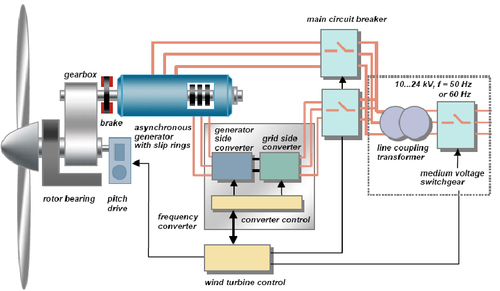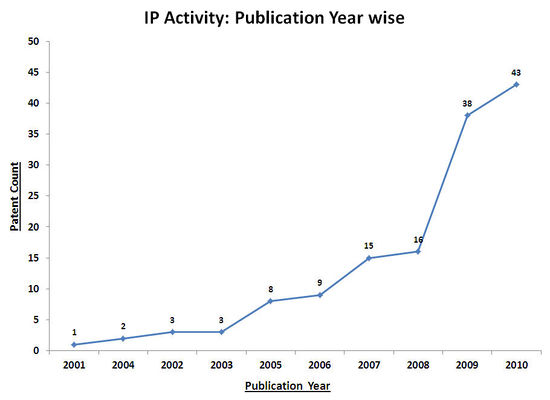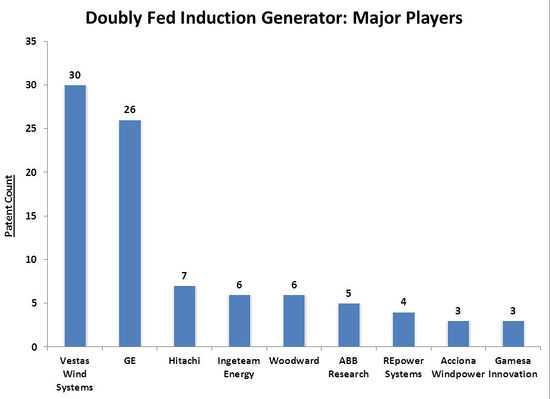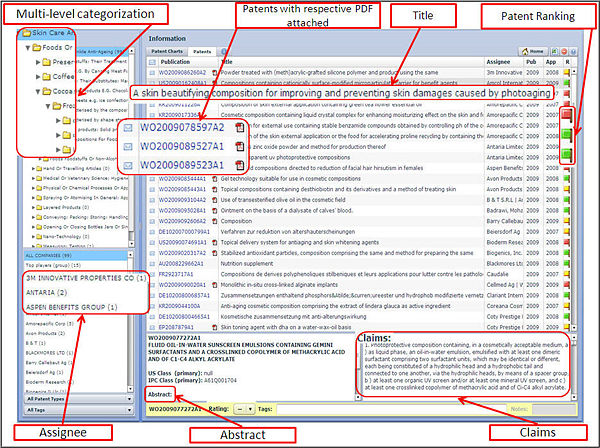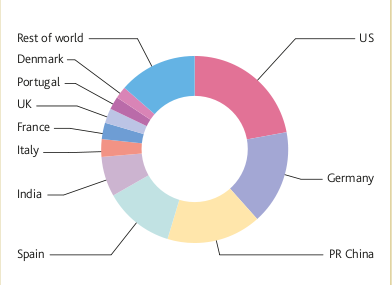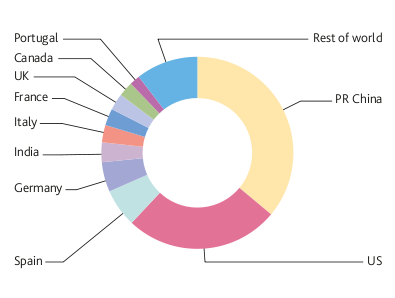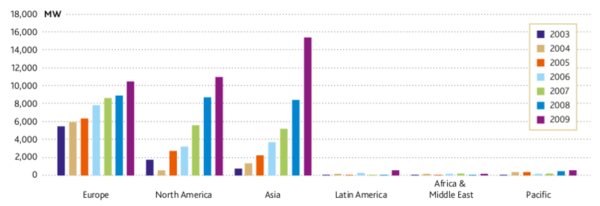Difference between revisions of "Wind Energy"
Crazypaddu (Talk | contribs) (→File section) |
Crazypaddu (Talk | contribs) (→Introduction) |
||
| Line 8: | Line 8: | ||
* Harnessing renewable alternative energy is the ideal way to tackle the energy crisis, with due consideration given to environmental pollution, that looms large over the world. | * Harnessing renewable alternative energy is the ideal way to tackle the energy crisis, with due consideration given to environmental pollution, that looms large over the world. | ||
| − | * Renewable energy is also called "clean energy" or "green power" because it doesn’t pollute the air or the water. Wind energy is one such renewable energy source that harnesses natural wind power. | + | * Renewable energy is also called "clean energy" or "green power" because it doesn’t pollute the air or the water. Wind energy is one such renewable energy source that harnesses natural wind power. Click on the link below to know more about |
[[Wind Energy Background]] | [[Wind Energy Background]] | ||
Revision as of 03:48, 14 March 2011
Summary:
This report presents a brief summary about wind energy and present day technologies available for horizontal wind turbines. A detailed taxonomy for horizontal axis wind turbines is presented covering parts of the turbine, control systems, applications among others. A detailed landscape analysis of patent and non-patent literature is done with focus on Doubly-fed Induction Generator (DFIG) used in the horizontal axis wind turbines for efficient power generation. Existing products' information of major players in the market is also compiled for Doubly-fed induction generators. Existing market and future market prediction for wind energy based power generation is presented.
Contents
Introduction
- Humans have been using wind power for at least 5000 BC to propel sailboats and sailing ships, and architects have used wind-driven natural ventilation in buildings since similarly ancient times. The use of wind to provide mechanical power came later.
- Harnessing renewable alternative energy is the ideal way to tackle the energy crisis, with due consideration given to environmental pollution, that looms large over the world.
- Renewable energy is also called "clean energy" or "green power" because it doesn’t pollute the air or the water. Wind energy is one such renewable energy source that harnesses natural wind power. Click on the link below to know more about
In order to overcome the problems associated with fixed speed wind turbine system and to maximize the wind energy capture, many new wind farms are employing variable speed wind energy conversion systems (WECS) with doubly-fed induction generator (DFIG). It is the most popular and widely used scheme for the wind generators due to its advantages.
Doubly-fed Induction Generator
For variable-speed systems with limited variable-speed range, e.g. ±30% of synchronous speed, the Doubly-fed Induction Generator(DFIG) can be an interesting solution.This is mainly due to the fact that the power electronic converter only has to handle a fraction (20-30%) of the total power as the converters are connected to the rotor and not to the stator. There- fore, the losses in the power electronic converter can be reduced, compared to a system where the converter has to handle the total power.The overall structure of wind power generation through DFIG as shown in the figure below.
The present study on the IP activity in the area of horizontal axis wind turbines with focus on Doubly-fed Induction Generator (DFIG) is based on a search conducted on Thomson Innovation.
Control patents
| |
|
|
|
|
| |
|
|
|
Brushless doubly-fed induction machines employing dual cage rotors |
| |
|
|
|
Doubly fed induction machine |
| |
|
|
|
Control system for doubly fed induction generator |
| |
|
|
|
Power converter for doubly-fed power generator system |
| |
|
|
|
Variable speed wind turbine with doubly-fed induction generator compensated for varying rotor speed |
| |
|
|
|
Doubly-controlled asynchronous generator |
Thomson Innovation Search
A search is carried out using a combination of keywords and classifications in Thomson Innovation. The Classifications identified relevant to the scope of the search are:
IPC/ ECLA Classes
| IPC/ ECLA Class | Definition |
| F03D9/00 | Machines or engines for liquids; wind, spring, or weight motors; producing mechanical power or a reactive propulsive thrust, not otherwise provided for / Wind motors / Adaptations of wind motors for special use; Combinations of wind motors with apparatus driven thereby (aspects predominantly concerning driven apparatus) |
| F03D9/00C | Machines or engines for liquids; wind, spring, or weight motors; producing mechanical power or a reactive propulsive thrust, not otherwise provided for / Wind motors / Adaptations of wind motors for special use; Combinations of wind motors with apparatus driven thereby (aspects predominantly concerning driven apparatus)/ the apparatus being an electrical generator |
| H02J3/38 | Generation, conversion, or distribution of electric power / Circuit arrangements or systems for supplying or distributing electric power; systems for storing electric energy / Circuit arrangements for ac mains or ac distribution networks/ Arrangements for parallely feeding a single network by two or more generators, converters or transformers |
| H02K17/42 | Generation, conversion, or distribution of electric power / dynamo-electric machines / Asynchronous induction motors; Asynchronous induction generators/ Asynchronous induction generators |
| H02P9/00 | Generation, conversion, or distribution of electric power / control or regulation of electric motors, generators, or dynamo-electric converters; controlling transformers, reactors or choke coils / Arrangements for controlling electric generators for the purpose of obtaining a desired output |
US Classes
| US Class | Definition |
| 290/044 | Prime-mover dynamo plants/ electric control / Fluid-current motors / Wind |
| 290/055 | Prime-mover dynamo plants/ fluid-current motors / Wind |
| 318/727 | Electricity: motive power systems / Induction motor systems |
| 322/047 | Electricity: single generator systems / generator control / Induction generator |
Concept Table
| S.No | Concept1 | Concept1 | Concept1 |
| Definition | Doubly fed | Induction | Generator |
| 1 | doubly fed | induction | generator |
| 2 | double output | asynchronous | machines |
| 3 | dual fed | systems | |
| 4 | dual feed | ||
| 5 | dual output |
Search Strategy
The databases covered in the search include: US Grant, GB App, US App, FR App, WO App, DE Util, EP Grant, DE Grant, EP App, DE App, JP Util, JP Grant, JP App, CN Util, CN App, KR Util , KR Grant, KR App, Other, DWPI
Time line:01/01/1836 to 07/03/2011
| S.No | Remarks | Search String | No. of Hits |
| 1 | Doubly fed induction generator keywords | CTB=(((((Doubl*3 OR dual*3 OR two) ADJ3 (power*2 OR output*4 OR control*4 OR fed OR feed*3)) NEAR5 (induction OR asynchronous)) NEAR5 (generat*3 OR machine*1 OR dynamo*1)) OR DFIG); | 864 hits |
| 2 | Induction motor classes AND Doubly fed generator keywords | (UC=(318/727 OR 322/047) OR AIOE=(H02K001742)) AND ALL=(((((Doubl*3 OR dual*3 OR two) ADJ3 (power*2 OR output*1 OR control*4 OR fed OR feed*3)) NEAR5 (generat*3 OR machine*1 OR dynamo*1))) OR DFIG); | 108 hits |
| 3 | Broad classes of generators AND Doubly fed induction generator keywords | (UC=(290/044 OR 290/055) OR AIOE=(F03D000900C OR H02J000338 OR F03D0009* OR H02P0009*)) AND ALL=(((((Doubl*2 OR dual*3 OR two) ADJ3 (power*2 OR output*1 OR control*3 OR fed OR feed*3)) NEAR5 (induction OR asynchronous)) NEAR5 (generat*3 OR machine*1 OR dynamo*1)) OR DFIG); | 757 hits |
| 4 | French keywords | CTB=((((Doubl*3 OR dual*3OR ADJ two OR deux) NEAR4 (nourris OR feed*3 OR puissance OR sortie*1 OR contrôle*1)) NEAR4 (induction OR asynchrone*1) NEAR4 (générateur*1 OR generator*1 OR machine*1 OR dynamo*1)) OR DFIG); | 257 hits |
| 5 | German keywords | CTB=(((((doppel*1 OR dual OR two OR zwei) ADJ3 (Ausgang OR Ausgänge OR Kontroll* OR control*4 OR gesteuert OR Macht OR feed*1 OR gefüttert OR gespeiste*1)) OR (doppeltgefüttert OR DOPPELTGESPEISTE*1)) NEAR4 (((Induktion OR asynchronen) NEAR4 (generator*2 OR Maschine*1 OR dynamo*1)) OR (INDUKTION?MASCHINEN OR INDUKTION?generatoren OR Asynchronmaschine OR Asynchrongenerator))) OR DFIG); | 302 hits |
| 6 | ALL=(((((((Doubl*3 OR dual*3) ADJ3 (power*2 OR output*4 OR control*4 OR fed OR feed*3))) NEAR5 (generat*3 OR machine*1 OR dynamo*1))) SAME wind) OR (DFIG SAME wind)) AND DP>=(18360101); | 1358 hits | |
| 7 | Combined Query | 1 OR 2 OR 3 OR 4 OR 5 OR 6 | 1807 hits (916 INPADOC Families) |
Acronyms
- CTB : Claims Title Abstract
- UC : US Classification
- AIOC: Any IPC or ECLA Classification
- ALL :All text fields
Taxonomy
Sample Analysis
A sample of 139 patents from the search are analysed based on the taxonomy.
Provided a link below for sample spread sheet analysis for doubly-fed induction generators.
Patent Analysis
| |
|
|
|
|
| |
| |
| |||||
| |
|
|
|
Method of and apparatus for operating a double-fed asynchronous machine in the event of transient mains voltage changes | The short-circuit-like currents in the case of transient mains voltage changes lead to a corresponding air gap torque which loads the drive train and transmission lines can damages or reduces the drive train and power system equipments. | The method presents that the stator connecting with the network and the rotor with a converter. The converter is formed to set a reference value of an electrical amplitude in the rotor, by which a reference value of the electrical amplitude is setted in the rotor after attaining a transient mains voltage change, such that the rotor flux approaches the stator flux. |
| |
|
|
|
Variable speed wind turbine with doubly-fed induction generator compensated for varying rotor speed | The DFIG system has poor damping of oscillations within the flux dynamics due to cross coupling between active and reactive currents, which makes the system potentially unstable under certain circumstances and complicates the work of the rotor current controller. These oscillations ca damage the drive train mechanisms. | A comprensation block is arranged, which feeds a compensation control output to the rotor of the generator. The computation unit computes the control output during operation of the turbine to compensate partly for dependencies on a rotor angular speed of locations of poles of a generator transfer function, so that the transfer function is made independent of variations in the speed during operation of the turbine which eliminates the osicllations and increases the efficinecy of the wind turbine. |
| |
|
|
|
Current limitation for a double-fed asynchronous machine | Abnormal currents can damage the widings in the doubly- fed induction gnerator. Cntrolling these currents with the subordinate current controllers cannot be an efficient way to extract the maximum amount of active power. | The method involves delivering or receiving of a maximum permissible reference value of an active power during an operation of a double-fed asynchronous machine, where predetermined active power and reactive power reference values are limited to a calculated maximum permissible active and reactive power reference values, and hence ensures reliable regulated effect and reactive power without affecting the power adjustment, the rotor is electrically connected to a pulse-controlled inverter by slip rings with a static frequency changer, and thus a tension with variable amplitude and frequency is imposed in the rotor. |
| |
|
|
|
Method and system of control of the converter of an electricity generation facility connected to an electricity network in the presence of voltage sags in said network | Double-fed asynchronous generators are very sensitive to the faults that may arise in the electricity network, such as voltage sags. During the sag conditions the current which appears in said converter may reach very high values, and may even destroy it. | During the event of a voltage sag occurring, the converter imposes a new setpoint current which is the result of adding to the previous setpoint current a new term, called demagnetizing current, It is is proportional to a value of free flow of a generator stator. A difference between a value of a magnetic flow in the stator of the generator and a value of a stator flow associated to a direct component of a stator voltage is estimated. A value of a preset calculated difference is multiplied by a factor for producing the demagnetizing current. |
| |
|
|
|
Variable speed wind turbine having an exciter machine and a power converter not connected to the grid | a) The active switching of the semiconductors of the grid side converter injects undesirable high frequency harmonics to the grid.b) The use of power electronic converters (4) connected to the grid (9) causes harmonic distortion of the network voltage. | Providing the way that power is only delivered to the grid through the stator of the doubly fed induction generator, avoiding undesired harmonic distortion. Grid Flux Orientation (GFO) is used to accurately control the power injected to the grid. An advantage of this control system is that it does not depend on machine parameters, which may vary significantly, and theoretical machine models, avoiding the use of additional adjusting loops and achieving a better power quality fed into the utility grid. |
| |
|
|
|
Frequency converter for a double-fed asynchronous generator with variable power output and method for its operation | Optislip circuit with a resistor is used when speed is above synchronous speed, results in heating the resistor and thus the generator leads to limitation of operation in supersynchronous range which results tower fluctions. | Providing a back-to-back converter whic contains the inverter circuit has direct current (DC) inputs , DC outputs, and a rotor-rectifier connected to a rotor of a dual feed asynchronous generator. A mains inverter is connected to a power grid, and an intermediate circuit connects one of the DC inputs with the DC outputs. The intermediate circuit has a semiconductor switch between the DC outputs, an intermediate circuit condenser between the DC inputs, and a diode provided between the semiconductor switch and the condenser. Thus the sysem is allowed for any speed of wind and reduces the tower fluctuations. |
| |
|
|
|
Power converter for doubly-fed power generator system | During the ground faults, excess currents is induced in the secondary windings and flows into power converter connected o secondar side and may danage the power converter. Conventional methos of incresing the capacity of the power cnverter increases system cost , degrade the system and takes time to activate the system to supply power again. | The generator provided with a excitation power converter connected to secondary windings of a doubly-fed generator via impedance e.g. reactor, and a diode rectifier connected in parallel to the second windings of the doubly-fed generator via another impedance. A direct current link of the rectifier is connected in parallel to a DC link of the converter. A controller outputs an on-command to a power semiconductor switching element of the converter if a value of current flowing in the power semiconductor switching element is a predetermined value or larger. |
| |
|
|
|
System and method of operating double fed induction generators | Wind turbines with double fed induction generators are sensitive to grid faults.Conventional methods are not effective to reduce the shaft stress during grid faults and slow response and using dynamic vltage restoreer (DVR) is cost expensive. | The protection system has controlled impedance devices.Impedance device has bidirectional semiconductors such triac, assembly of thyristors or anti-parallel thyristors. Each of the controlled impedance devices is coupled between a respective phase of a stator winding of a double fed induction generator and a respective phase of a grid side converter. The protection system also includes a controller configured for coupling and decoupling impedance in one or more of the controlled impedance devices in response to changes in utility grid voltage and a utility grid current. High impedance is offered to the grid during network faults to isolate the dual fed wind turbine generator. |
| |
|
|
|
Control and protection of a doubly-fed induction generator system | A short-circuit in the grid causes the generator to feed high stator-currents into the short-circuit and the rotor-currents increase very rapidly which cause damage to the power-electronic components of the converter connecting the rotor windings with the rotor-inverter. | The converter is provided with a clamping unit which is triggered from a non-operation state to an operation state, during detection of over-current in the rotor windings. The clamping unit comprises passive voltage-dependent resistor element for providing a clamping voltage over the rotor windings when the clamping unit is triggered. |
| |
|
|
|
Method for controlling doubly-fed machine | Controlling the double fed machines on the basis of inveter control to implement the targets set for the machine, this model is extremely complicated and includes numerous parameters that are often to be determined. | A method is provided to use a standard scalar-controlled frequency converter for machine control. A frequency reference for the inverter with a control circuit, and reactive power reference are set for the machine. An rotor current compensation reference is set based on reactive power reference and reactive power. A scalar-controlled inverter is controlled for producing voltage for the rotor of the machine, based on the set frequency reference and rotor current compensation reference. |
Click on the link below to view detailed analysis sheet for Doubly-Fed Induction Generator Patent Literature
* Sample analysis on Doubly-Fed Induction Generator-Patent Literature
Top Cited Patents
| |
|
|
|
| |
US5289041A | Speed control system for a variable speed wind turbine | |
| |
US4982147A | Power factor motor control system | |
| |
US5028804A | Brushless doubly-fed generator control system | |
| |
US5239251A | Brushless doubly-fed motor control system | |
| |
US6856038B2 | Variable speed wind turbine having a matrix converter | |
| |
WO1999029034A1 | A method and a system for speed control of a rotating electrical machine with flux composed of two quantities | |
| |
WO1999019963A1 | Rotating electric machine | |
| |
US7015595B2 | Variable speed wind turbine having a passive grid side rectifier with scalar power control and dependent pitch control | |
| |
US4763058A | Method and apparatus for determining the flux angle of rotating field machine or for position-oriented operation of the machine | |
| |
US7095131B2 | Variable speed wind turbine generator | |
Article Analysis
| |
|
|
|
|
| |
Study on the Control of DFIG andIts Responses to Grid Disturbances | |
Power Engineering Society General Meeting, 2006. IEEE | Presented dynamic model of the DFIG, including mechanical model, generator model, and PWM voltage source coverters. Vector control strategies adapted for both the RSC and GSC to control speed and reactive power independently. controlling desigining methods, such as pole-placement method and the internal model control are used. Matlab/Simulink is used for simulation. |
| |
Application of Matrix Converter for Variable Speed Wind Turbine Driving an Doubly Fed Induction Generator | |
Power Electronics, Electrical Drives, Automation and Motion, 2006. SPEEDAM 2006. | A matrix converter is replaced with back to back converter in a variable speed wind turbine using doubly fed induction generator. Stable operation is achieved by stator flux oriented control techinque and the sytem opertaed in both sub and super synchronous modes, achieved good results. |
| |
Optimal Power Control Strategy of Maximizing Wind Energy Tracking and Conversion for VSCF Doubly Fed Induction Generator System | |
Power Electronics and Motion Control Conference, 2006. IPEMC 2006. CES/IEEE 5th International | Proposed a new optimal control strategy of maximum wind power extraction stratagies and testified by simulation. The control algorithm also used to minimize the losses in the generator. The dual passage excitation control strategy is applied to decouple the active and reactive powers. With this control system, the simulation results shows the good robustness and high generator efficiency is achieved. |
| |
A Torque Tracking Control algorithm for Doubly–fed Induction Generator | |
Journal of ELECTRICAL ENGINEERING | Proposed a torque tracking control algorithm for Doubly fed induction generator using PI controllers. It is achieved by controlling the rotor currents and using a stator voltage vector reference frame. |
| |
Fault Ride Through Capability Improvement Of Wind Farms Using Doubly Fed Induciton Generator | |
Universities Power Engineering Conference, 2008. UPEC 2008. 43rd International | An active diode bridge crowbar switch presented to improve fault ride through capability of DIFG. Showed different parameters related to crowbar such a crowbar resistance, power loss, temparature and time delay for deactivation during fault. |
Click on the link below to view detailed analysis sheet for Doubly-Fed Induction Generator-Non Patent Literature
Top cited Articles
IP Trend Analysis
Patenting activity has seen high growth rate in the last two years.
Vestas Wind Systems and General Electric are the major players in this technology field.
Dashboard
Dashboard Link
Dashboard for doubly fed induction generator
- Flash Player is essential to view the Dashboard
Products
| |
|
|
|
| |
|
|
Rated power 2.0 MW; Operating temperature -30°C to 40°; Frequency: 50 Hz/60 Hz;Number of poles 4-pole |
| |
Rated power 1.8/2.0 MW; Operating temperature -30°C to 40°; Frequency: 50 Hz/60 Hz;Number of poles 4-pole (50 Hz)/6-pole (60 Hz) | ||
| |
Rated power 3.0 MW; Operating temperature -30°C to 40°; Frequency: 50 Hz/60 Hz;Number of poles 4-pole | ||
| |
|
|
Rated voltage 690V; rated current 1670A; frequency 50Hz; rotor rated voltage 1840V; rotor rated current 670A;, Poles 4 Pole; rated speed 1660rpm; power speed range of 520-1950rmp; Insulation Class H; protection class IP54; center height H = 500mm; motor temperature rise =<95K |
| |
|
|
Rated Voltage 690 V ac; Frequency 50 Hz; Protection class IP 54; Number of poles 4; Rotational speed 900:1,900 rpm (rated 1,680 rpm) (50Hz); Rated Stator Current 1,500 A @ 690 V; Power factor (standard) 0.98 CAP - 0.96 IND at partial loads and 1 at nominal power. *; Power factor (optional) 0.95 CAP - 0.95 IND throughout the power range. |
| |
|
|
Rated power 2.5 MW; Rated volatge 690V; frequency 50/60Hz; Cooling systems: liquid/air. |
| |
Rated power 2.5 MW; Rated volatge 690V; frequency 50/60Hz; Cooling systems: liquid/air. | ||
| |
Rated power 2.4 MW; Rated volatge 690V; frequency 50/60Hz; Cooling systems: liquid/air. | ||
| |
Rated power 2.5 MW; Rated volatge 690V; frequency 50/60Hz; Cooling systems: liquid/air. | ||
| |
|
|
|
| |
|
|
Rated power1550KW; Rated speed1755 r/min; Speed range975~1970 r/min;Stator rated voltage690V±10%; Stator rated current1115A; Rotor rated voltage320V; Rotor rated current430A;Winding connectionY / Y; Power factor0.95 (Lead) ~ 0.95Lag; Protection classIP54; Insulation classH; Work modeS1; Installation modeIM B3; Cooling modeAir cooling; Center high500mm; Pole number4; Weight6950kg |
| |
|
|
Rated Power 0.5 -1 KW; Rated voltage : 460/ 575/ 690 V; frequency 50/ 60 Hz; No. Of Poles 4/6; Ambient Temp.(°C) -40 to 50; Speed Range (% of Synch. Speed) 68% to 134%; Power Factor (Leading) -0.90 to +0.90 ; Insulation Class H/F; Efficiency >= 96% |
| |
Rated Power 1-2 kW; Rated voltage : 460/ 575/ 690 V; frequency 50/ 60 Hz; No. Of Poles 4/6; Ambient Temp.(°C) -40 to 50; Speed Range (% of Synch. Speed) 68% to 134%; Power Factor (Leading) -0.90 to +0.90 ; Insulation Class H/F; Efficiency >= 96% | ||
| |
Rated Power 2-3kW; Rated voltage : 460/ 575/ 690 V; frequency 50/ 60 Hz; No. Of Poles 4/6; Ambient Temp.(°C) -40 to 50; Speed Range (% of Synch. Speed) 68% to 134%; Power Factor (Leading) -0.90 to +0.90 ; Insulation Class H/F; Efficiency >= 96% | ||
| |
|
Rated Power 1500MW; Voltage 690 V ac; Frequency 50 Hz; Protection class IP 54; Number of poles 4; Rotational speed 900:1,900 rpm (rated 1,680 rpm) (50Hz); Rated Stator Current 1,500 A @ 690 V; Power factor (standard) 0.98 CAP - 0.96 IND at partial loads and 1 at nominal power. *; Power factor (optional) 0.95 CAP - 0.95 IND throughout the power range. | |
| |
Rated Power 3000MW; Voltage 690 V ac; Frequency 50 Hz; Protection class IP 54; Number of poles 4; Rotational speed 900:1,900 rpm (rated 1,680 rpm) (50Hz); Rated Stator Current 1,500 A @ 690 V; Power factor (standard) 0.98 CAP - 0.96 IND at partial loads and 1 at nominal power. *; Power factor (optional) 0.95 CAP - 0.95 IND throughout the power range. | ||
| |
|
|
Rated power 1.5/2.5 MW; Frequency (Hz) 50/60; |
Market Research
Major Players
Vestas Wind Systems, General Electric and Gamesa Innovation & Technology are the top players in terms of installed power capacity in the year 2007.
| |
|
| |
| |
|
| |
| |
|
| |
| |
|
| |
| |
|
| |
| |
|
| |
| |
|
| |
| |
|
| |
| |
|
| |
| |
|
| |
| |
|
| |
Source:Wind power companies
Market Overview
- The world's wind industry defied the economic downturn in 2008 and by he end of the year 2009, the sector saw its annual market grow by 41.5% over 2008, and total global wind power capacity increased by 31.7% to 158GW in 2009
- US, China and Germany together hold more than 50% of the global wind power capacity
- Asia and North America have seen tremendous growth in the installed wind power capacity over the last 6 years
- Asia was the world's largest regional market for wind energy with capacity additions amounting to 15.4GW. China was the world's largest market in 2009, more than doubling its capacity from 12.1GW in 2008 to 25.8GW, adding a staggering 13.8GW of capacity
- China and the US account for more than 60% of the new installed capacity of 38.3GW in 2009. India's total installed capacity increased to 10.9GW with 1.3GW of new installed capacity in 2009
- The 2009 market for turbine installations was worth about 45 bn € or 63 bn US$ and about half a million people are now employed by the wind industry around the world
Market Forecast
- Global wind power capacity could reach 2,300 GW by 2030, providing up to 22% of the world's electricity needs, from the existing 2.2% in 2010.
- Global wind capacity will stand at 409GW up from 158GW at the end of 2008. During 2014, 62.5 GW of new capacity will be added to the global total, compared to 38.3 GW in 2009
- The annual growth rates during this period will average 20.9% in terms of total installed capacity, and 10.3% for annual market growth
- Three regions will continue to drive the expansion of wind energy capacity: Asia, North America and Europe
- Asia will remain the fastest growing market in the world, driven primarily by China, which is set to continue the rapid upscaling of its wind capacity and hold its position as the world’s largest annual market. Annual additions are expected to be well over 20 GW in China by 2014
- Sustained growth is also expected in India, which will increase its capacity steadily by 2 GW every year, and be complemented by growth in other Asian markets, including Japan, Taiwan, South Korea and the Philippines, and potentially some others
- By 2014, the annual market will reach 14.5 GW, and a total of 60 GW will be installed in Europe over this five year period
Source:GWEC's Global Wind Report 2009
File section
Click on the link to download worksheet
Insights
- USA, China, Germany, Spain and India share major part of wind energy generation in the year 2010.
- Vestas Wind Energy Systems and General Electric are the major players in wind energy generation technology.
- Patenting activity has seen high growth rate in the years 2009 and 2010.
- Research activity mainly going on rating and controlling of the Doubly-fed induction generation systems. Out of 139 patents 120 patents are discussing about controlling the DFIG.
- Continuous Operation of the DFIG system during weak and storm winds, grid voltage sags, and grid faults are major issues in current scenario. Among 28 patents covering DFIG operation, 24 patents are focusing on grid connected mode of operation.
- Woodward GMBH is a new and fast developing player in the field of DFIG technology,and filed 10 patent applications in the field in year 2010, while it has no prior IP activity.
Like this report?
This is only a sample report with brief analysis
Dolcera can provide a comprehensive report customized to your needs
Contact Dolcera
| Samir Raiyani |
|---|
| Email: info@dolcera.com |
| Phone: +1-650-269-7952 |
